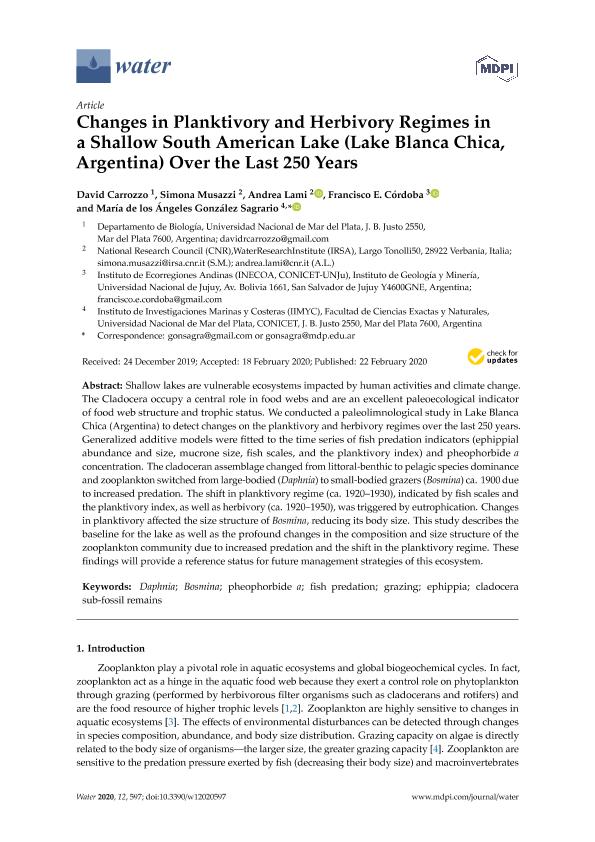Artículo
Changes in planktivory and herbivory regimes in a shallow South American lake (Lake Blanca Chica, Argentina) over the last 250 years
Carrozzo, David Ricardo; Musazzi, Simona; Lami, Andrea; Cordoba, Francisco Elizalde ; Gonzalez Sagrario, Maria de Los Angeles
; Gonzalez Sagrario, Maria de Los Angeles
 ; Gonzalez Sagrario, Maria de Los Angeles
; Gonzalez Sagrario, Maria de Los Angeles
Fecha de publicación:
02/2020
Editorial:
Multidisciplinary Digital Publishing Institute
Revista:
Water
ISSN:
2073-4441
Idioma:
Inglés
Tipo de recurso:
Artículo publicado
Clasificación temática:
Resumen
Shallow lakes are vulnerable ecosystems impacted by human activities and climate change. The Cladocera occupy a central role in food webs and are an excellent paleoecological indicator of food web structure and trophic status. We conducted a paleolimnological study in Lake Blanca Chica (Argentina) to detect changes on the planktivory and herbivory regimes over the last 250 years. Generalized additive models were fitted to the time series of fish predation indicators (ephippial abundance and size, mucrone size, fish scales, and the planktivory index) and pheophorbide a concentration. The cladoceran assemblage changed from littoral-benthic to pelagic species dominance and zooplankton switched from large-bodied (Daphnia) to small-bodied grazers (Bosmina) ca. 1900 due to increased predation. The shift in planktivory regime (ca. 1920-1930), indicated by fish scales and the planktivory index, as well as herbivory (ca. 1920-1950), was triggered by eutrophication. Changes in planktivory affected the size structure of Bosmina, reducing its body size. This study describes the baseline for the lake as well as the profound changes in the composition and size structure of the zooplankton community due to increased predation and the shift in the planktivory regime. These findings will provide a reference status for future management strategies of this ecosystem.
Archivos asociados
Licencia
Identificadores
Colecciones
Articulos(INECOA)
Articulos de INSTITUTO DE ECORREGIONES ANDINAS
Articulos de INSTITUTO DE ECORREGIONES ANDINAS
Citación
Carrozzo, David Ricardo; Musazzi, Simona; Lami, Andrea; Cordoba, Francisco Elizalde; Gonzalez Sagrario, Maria de Los Angeles; Changes in planktivory and herbivory regimes in a shallow South American lake (Lake Blanca Chica, Argentina) over the last 250 years; Multidisciplinary Digital Publishing Institute; Water; 12; 2; 2-2020; 1-15
Compartir
Altmétricas



